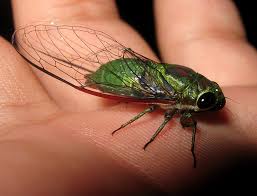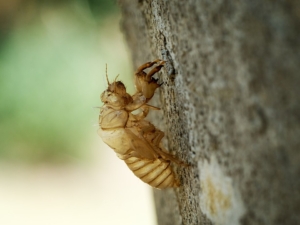SCORES & OUTDOORS: Cicada’s songs fill the air
 by Roland D. Hallee
by Roland D. Hallee
Last week, while doing some yard work, my wife noticed some insects on our outdoor fire pit. When summoned, I went over and identified the “bug” as the cicada exoskeleton, the part the cicada leaves behind its external skeleton, a hard, protective outer shell. We counted 11 of them. As a cicada grows, it outgrows its exoskeleton and must molt, shedding the old, hard shell and emerging as a larger, soft-bodied form.
The cicadas are a superfamily of insects, with more than 3,000 species described from around the world. Cicadas have prominent eyes set wide apart, short antennae, and membranous front wings. They have an exceptionally loud song, produced in most species by the rapid buckling and unbuckling of drum-like tymbals. They typically live in trees, feeding on watery sap from xylem tissue, and laying their eggs in a slit in the bark. Most cicadas are cryptic. The vast majority of species are active during the day as adults, with some calling at dawn or dusk. Only a rare few species are known to be nocturnal.
One exclusively North American genus, (the periodical cicadas), which spend most of their lives as underground nymphs, emerge in predictable intervals of 13 or 17 years, depending on the species and the location. The unusual duration and synchronization of their emergence may reduce the number of cicadas lost to predation, both by making them a less reliably available prey (so any predator that evolved to depend on cicadas for sustenance might starve waiting for their emergence), and by emerging in such huge numbers they will satiate any remaining predators before losing enough of their number to threaten their survival as a species.
The annual cicadas are species that emerge every year. Though these cicadas’ life cycles can vary from one to nine or more years as underground nymphs, their emergence above ground as adults is not synchronized, so some members of each species appear every year.
The “singing” of male cicadas is produced principally and in the majority of species using a special structure called a tymbal, a pair of which lies below each side of the anterior abdominal region. The structure is buckled by muscular action and, being made of resilin, unbuckles rapidly on muscle relaxation, producing their characteristic sounds. Some cicadas, however, have mechanisms for stridulation, sometimes in addition to the tymbals. Here, the wings are rubbed over a series of midthoracic ridges. Although only males produce the cicadas’ distinctive sounds, both sexes have membranous structures called tympana (singular – tympanum) by which they detect sounds, the equivalent of having ears.
For the human ear, telling precisely where a cicada song originates is often difficult. The pitch is nearly constant, the sound is continuous to the human ear, and cicadas sing in scattered groups. In addition to the mating song, many species have a distinct distress call, usually a broken and erratic sound emitted by the insect when seized or panicked. Some species also have courtship songs, generally quieter, and produced after a female has been drawn to the calling song. Males also produce encounter calls, whether in courtship or to maintain personal space within choruses.
Most cicadas go through a life cycle that lasts two – five years. Some species have much longer life cycles, such as the North American genus, which has a number of distinct “broods” that go through either a 17-year or in some parts of the region, a 13-year life cycle. For example, a 17-year cicada with a predator with a five-year life cycle will only be threatened by a peak predator population every 85 (5 × 17) years, while a non-prime cycle such as 15 would be endangered at every year of emergence. Cicadas are commonly eaten by birds and mammals, as well as bats, wasps, mantises, spiders, and robber flies. In times of mass emergence of cicadas, various amphibians, fish, reptiles, mammals, and birds change their foraging habits so as to benefit from the glut. Newly-hatched nymphs may be eaten by ants, and nymphs living underground are preyed on by burrowing mammals such as moles.but observations of predator responses refute the claim.
In mythology and folklore Cicadas have been used as money, in folk medicine, to forecast the weather, to provide song (in China), and in folklore and myths around the world.
Cicadas feed on sap; they do not bite or sting in a true sense, but may occasionally mistake a person’s arm for a plant limb and attempt to feed. Male cicadas produce very loud calls that can damage human hearing.
Cicadas are not major agricultural pests, but in some outbreak years, trees may be overwhelmed by the sheer numbers of females laying their eggs in the shoots. Small trees may wilt and larger trees may lose small branches. Although in general, the feeding activities of the nymphs do little damage, during the year before an outbreak of periodic cicadas, the large nymphs feed heavily and plant growth may suffer.[111] Some species have turned from wild grasses to sugarcane, which affects the crop adversely, and in a few isolated cases, females have oviposited on cash crops such as date palms, grape vines, citrus trees, asparagus, and cotton. Cicadas sometimes cause damage to ornamental shrubs and trees, mainly in the form of scarring left on tree branches where the females have laid their eggs. Branches of young trees may die as a result.
Now we know a little more about the insect that makes that loud, buzzing noise in mid-summer.
Roland’s trivia question of the week:
What former New England Patriots player was nicknamed “the law firm”?
Responsible journalism is hard work!
It is also expensive!
If you enjoy reading The Town Line and the good news we bring you each week, would you consider a donation to help us continue the work we’re doing?
The Town Line is a 501(c)(3) nonprofit private foundation, and all donations are tax deductible under the Internal Revenue Service code.
To help, please visit our online donation page or mail a check payable to The Town Line, PO Box 89, South China, ME 04358. Your contribution is appreciated!




Leave a Reply
Want to join the discussion?Feel free to contribute!